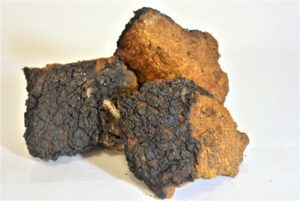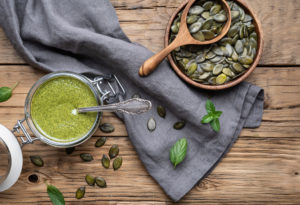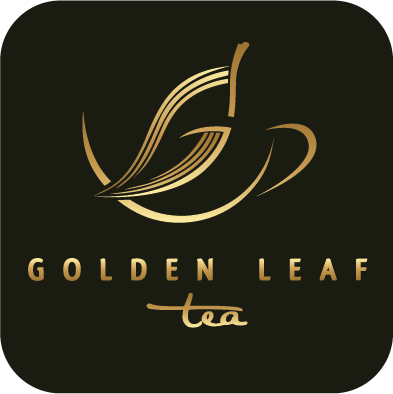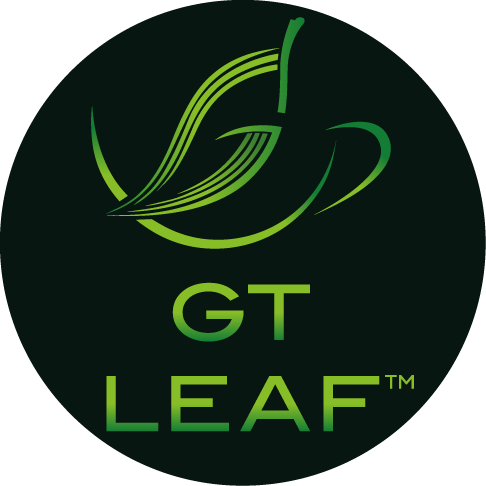
Chaga(Inonotus Obliquus)
Chaga is a fungus belonging to the Hymenochaetaceae family. It grows on Birch and other trees such as Alder. But for the purist, real good Chaga should only be grown on the Birch trees. More on the type of trees later.
Brewing Method For Chaga Tea
Use two large (or three small) chunks per every liter of water. Give the chunks a good thorough rinse, before placing the chunks in water. Place on the stove over medium heat, once the brewing water feels hot to the touch, lower the heat to the lowest possible setting. DO NOT boil. Let the chaga brew at the lowest heat setting for 1 to 2 hours until the water turns a dark dark color, sort of like black coffee. Chaga is done at this point. Enjoy hot with sugar and milk or enjoy cold with honey. This low heat brewing will give you the most delicious Chaga tea.
Store brewed chunks in the freezer in between brewings. Chunks can be re-used 3 -4 times.
Organic vs Wild
The “organic” designation means that the chaga is not harvested in the wild, and it is cultivated instead. The organics regulation demands the underlying commodity follow a series of strict growing and processing guideline. Our chaga cannot be certified organic because they are harvested in the wild on public forest lands.
Climbing the tree vs Cutting down the tree?
Climbing, of course. It doesn’t make sense to cut a tree down just to harvest chaga, for nothing else, it’s more dangerous and time consuming. And for another, it’s just not smart to be ruining the forests that feed us.
Birch vs Other trees
We get this questions a lot… We harvest Chaga off Birch trees. So the question here is: how would anyone know if the chaga is harvested off Birch or other types of trees? Technically, you don’t except what we tell you. But the reality is, our pickers harvest in Quebec, Norther BC, and New Brunswick, where there are lots and lots of Birch tree forests, it’s much easier and faster to scout out a patch of Birch trees with lots of Chaga. While chaga has been said to grow on Maple, Alder, Oak…etc. You would be hard pressed to find chaga growing on them. Most of the time, they may look like chaga chunk when in reality they are just worthless burl. (Worthless to us at least).
Whenever we work with a new picker, we always ask for a small piece of the bark to be attached to the big chunk of Chaga. This is still the norm for many field buyers during the Chaga season.
Spore print verification?
Nope. Can’t do. Yes, Chaga is a fungus, but unlike mushroom, the chaga body has no spores that you can do a print. The major concentration of spores mature in the birch tree trunk underneath the bark, appearing near the chaga. When this occurs, spores begin to spread and disperse through the air. When the spores enter the bark of a new host they form mycelium; this eventually destroys the bark creating a new outgrowth and another chaga begins to grow.
Can Chaga be damaged by being exposed to lights or sun or air or ?
Nope. Chaga is sensitive to moisture, as excess moisture will cause mold. If your chaga tastes bitter, then chances are your chaga was too wet and molded. Chaga has been reported to prevent UV damage to our skin. Refer to: https://www.ncbi.nlm.nih.gov/pmc/articles/PMC3887607/ for a quick read. Chaga also have incredibly strong cell walls, that things that will normally degrade herbs don’t quite apply here. EXCEPT excess moisture.
Chaga chunks vs powder vs extract?
We like to see our Chaga in the raw form, of course, we also grind chaga for wholesale too. When properly brewed, Chaga is a delicious caffeine free tea.
The powerful beta glucan and phenolics in Chaga are locked away behind its rigid and tough cell walls. Traditionally, there are three ways to break down the cell wall and achieve proper extraction, hot water extraction, alcohol extraction, and finally fermentation. To achieve the maximum benefit, chaga needs to go through both hot water and alcohol extractions to extract out many of the polysaccharides and beta glucans. There are lots of Chaga supplements out there, but with so little regulations, it is best to read the labels carefully to see the amount of standardized amounts of the polysaccharides and whatever extraction methods are used.

Pumpkin Kernels (Papitas)
Here are some of our favorite pumpkin seeds recipes.
Roasted Pumpkin Seed Kernels with Salt
Preheat oven to 350 degrees Fahrenheit. In a small bowl, dissolve 1 teaspoon of salt in 100ml of warm water. Combine the salt water with 3 cups of pumpkin seeds. Mix and coat. Drain off any salt liquid, if any. Spread in a single layer on a cookie sheet. Roast for 8-15 minutes.
The amount of time in the oven will be different depending on the amount of salt water. You have to simply note down the time needed. Do not toast until the pumpkin seeds becomes crispy in the oven, that will be overcooking them. At 5 minute mark, check, the seeds should be dry, and have no moisture. If the seeds are not yet read, then let it roast in 3 minute increments. Toaster oven will roast faster than the conventional full size ovens. Regardless of the type of the oven, the seeds will need anywhere from 8 to 15 minutes of toasting time. The seeds may still feel pliable while warm, which is normal, but after the seeds cool down, they will become crispy. Let cool completely before putting them in a tightly sealed jar or plastic bag. Enjoy.
Roasted Pumpkin Seeds Butter
Preheat oven to 350 degrees Fahrenheit. Roast the seeds for 10 minutes to bring out the sweet toasted nuttiness. Let them cool down to just warm to the touch.
We will be using a food processor to process the nut butter. Keep in mind, the blender will be turned on for an extended amount of time, it is ok to stop the blender at any time, andlet the machine rest. You do not want to burn out the motor.
This is where you can decide what you like in your pumpkin seeds butter. We like to put in a pinch of salt AND a spoonful of sugar. Some people add a spoonful of flavorless oil (canola) to make the blending easier. But all these additions are totally up to you.
Place no more than 2 cups of roasted nuts in a standard sized blender. Start blending. Stop the machine and scrape down after 1 minute. This will be a fairly long process. 3 minutes from crushed seeds to chunky paste. 3-5 minutes from chunky paste to a grainy butter. 5-8 minutes from grainy butter to smooth pumpkin seed butter.
Store finished pumpkin seed butter in a jar and in the fridge. Use up within a month.
TEA
All about Oolong
Q: What is it?
It is a semi-fermented (correct technical term is “semi-oxidized”) tea, coming from the universal tea plant, Camellia Sinensis.
Q: Ok…how is Oolong different than my green tea or black tea? Green tea does not go through any fermentation. Hence, “green”. After the tea leaves are picked, they go through a series of steaming, pan frying, shaping, and finally drying. That’s it.
Black tea is at the other spectrum. After the tea leaves are picked, they go through a series of withering, crushing, fermentation, rolling, and drying.
Oolong has slightly more steps, and it is sort of like a hybrid of the green and black. Meaning, it goes through a partial fermentation (oxidization), and several different firings and bakings. The results?A stunning liquid gold that can have a wide variety of flavors, simply stunning.
Q: Does Oolong have caffeine?
Yes! Usually, the darker the tea color, more caffeine it contains. But at the very most, the caffeine content is about ½ of a regular cup of coffee.
- Ok….now health benefits? Is there any?
Sure! Lots! The Chinese have known this for centuries, and now there are more and more scientific studies and researches done all over the world to quantify and document the benefits. The healthful benefits range from: boosting metabolism (aka aiding weight loss), lowering high blood pressure, lowering blood sugar, preventing cancer to reducing eczema. Just do a quick Google, and the lists go on.
- What is it that’s making Oolong tea having all these benefits?
Antioxidants! There are 10 times the amount of antioxidants in Oolong Tea than in any fruits and vegetables. Specifically, the antioxidants Oolong Tea contains are known as tea polyphenols. They are: catechins, theaflavins, tannins, EGCG, and flavonoids.
- Whole leaf?
Of course. All of our teas are whole leaf. We don’t believe in anything else. Even when we make tea bags, we use whole leaf. It is much less bitter.
- Brewing instruction?
Use hot boiling water for all of our oolong teas. Our oolong is robust and has gone through proper roasting that a hot boiling water is a must to bloom our tea. Use 3g of tea (a good teaspoon) per every cup of water. Start with 2 minutes of steep time, and adjust to your liking.
Our tea can be brewed at least 2 – 3 times. If you are brewing tradition Kung Fu Style , then many oolongs will be able to brew up to 7 times.
Jasmine Oolong
Our Jasmine oolong uses a Forever Spring oolong cultivar as a base, and we mix in the Jasmine buds and go through low temperature roasting three separate times so the Jasmine buds can naturally infuse the tea with flavor. This infusion imparts the very subtle and sweet scent into the already fragrant Forever Spring Oolong cultivar. The oolong tea from this point will go through the same roasting process to finish. Somewhere among all the roasting, the Jasmine Oolong undergoes a final scenting with natural Jasmine oils and flavors, and one more roasting to lock in the scent and flavor. Sorry, the number and duration of the roast and scenting is trade secret here. The result is a stunningly fragrant Jasmine Oolong that is out of this world. A great clean and sweet tasting oolong with a distinct Jasmine scent.
Country of Origin: Taiwan
Available in: Loose & Sachets
Milk Oolong
Our Milk Oolong uses the original “milk” Jin Xuan oolong cultivar. Jin Xuan cultivar is a Taiwan pioneered oolong tea cultivar that is especially noted for its milky scent. Here the natural milk scent means the creamy mouth feel that is distinctively Jin Xuan. The only oolong that can beat the creaminess is Alishan.
Taiwan Jin Xuan style is almost always on the lighter side. This means the oolong is never heavily fermented or roasted. The color of the brew is always a light yellow and the tea leaves are always green without any hint of darkness or yellow.
Milk oolong should never be dark, if it is, it is not the original Taiwan Milk Jin Xuan Oolong. The sweetness and mouth feel of a proper Milk Oolong is quite pleasant; the brewed liquor is fragrant and bright.
We take our traditional Jin Xuan Milk Oolong and when it is at the final roasting, we further enhanced it with natural milk flavoring to impart a more sweet creaminess scent to the oolong.
Country of Origin: Taiwan
Available in: Loose Tea only


